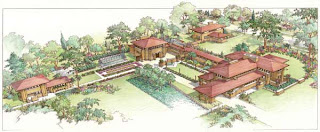In the run-up to Hallowe'en it's not entirely inappropriate to review some designs from the recent past and wonder:
what were they thinking?
And then, there are the classics of design that, nowadays, seem a little less than spectacular.
For example, the much-vaunted Tizio lamp designed by Richard Sapper, iconic in its day, that has become a token fixture, without which the house or office of a designer or architect (of a certain age) would not
be complete:

While, admittedly, this lamp was pretty damned cool in 1972, today it looks - well - rather
orthopaedic. A knee brace for your arthritic old uncle the architect. At $400 a pop from the MoMA store, really, ya gotta be kiddin' me, bro.
Then there's a certain odd Eames' chair -
if this isn't a joke, then I don't get it:

As much as I adore
everything else done by Ray and Charles Eames, Eames + Saarinen, the Eames Studio - I have to admit that the juxtaposition of the half-bathtub shell with the aeroplane struts atop the out-sized skids, er, I mean rockers is such a perverse statement of instability, of forcing the concept of the shell chair to such a purpose of the old-fashioned rocker, that I have to quibble.
A perfect case of too many ideas occupying one object.
Then, there's the bad design of early Frank Lloyd Wright's furniture. Yes - concepts taken to an extreme - but (even by The Master's own admission) guaranteed to skin your ankles every time you sit down or stand up:

And, beyond the lack of ergonomics, who wants to have to compete with a fqn
light fixture for attention at the dinner table?

The Gerrit Rietveld Red-Blue Chair

- and the Wave Hill version - which, in comparing these two images I can see that the Wave Hill crew altered the proportions, making it a
very comfortable sitting experience.

Manuel Saez deems this DiLonghi airconditioner that we have in HRN's Studio "butt-ugly". As we discussed, the controls are inscrutable; only the on/off button is clearly understandable.

The iPhone 3G, with its chromed case, which I felt to be less than satisfactory.

The Dieter Rams Braun travel clock (left)

And Braun radio designed by Rams (above).

A clam-style cellphone, which we all agree, is one of the ugliest things in everyday life.
A recruiting poster for THRUSH - the nemesis of The Man from U.N.C.L.E., which we mentioned in passing:

The
Stinger brand bug zapper, on which our guest Rich Thrush worked:

I have to say that this photograph is much better looking
than the thing in real life.
As for my Humanscale Freedom Chair, its list price is presently
only $1,305.00.

But, dear Listener, know that the
net price to designers - who may be purchasing such chairs on behalf of a corporate client, and marking up the cost of the chair to list or near list - is approximately 60% of list. So when
you next want to buy a high-design product
be sure to ask What's the trade price?
No one who's
not in
the trade would ask this.

The Phillipe Starck orange squeezer.


Views of the Starck lobby at 95 Wall Street, with the enormous chandeliers and Versailles Hall of Mirrors effect.
Stay tuned for further episodes of
Visual Victims Unit: Criminal Design Intent.Postscript:

The kind of IBM 16-color VGA laptop that so infuriated me.
"
1992: IBM introduces the PS/2 Model CL57SX,
IBM's first
color laptop computer"
Thanks for listening! Talk with again next time.
 The Old Masters luxuriated in their pursuit of aesthetics, often to the detriment of the quality of their buildings.
The Old Masters luxuriated in their pursuit of aesthetics, often to the detriment of the quality of their buildings.




























